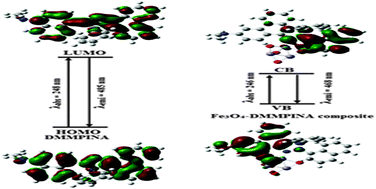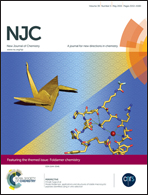Optical and theoretical studies on Fe3O4–imidazole nanocomposite and clusters†
Abstract
N,N-Dimethyl-4-(1-phenyl-1H-phenanthro[9,10-d]imidazol-2-yl)naphthalen-1-amine (DMPPINA) has been synthesised using sol–gel prepared TiO2 rutile as a catalyst under solvent free conditions and characterized by NMR spectral studies. The synthesised phenanthrimidazole bound magnetic nanoparticles (Fe3O4–DMPPINA composite) have been characterized using scanning electron microscopy (SEM), transmission electron microscopy (TEM), energy dispersive X-ray spectroscopy (EDS), X-ray diffractometry (XRD) and lifetime and Fourier-transform infrared spectroscopies (FT-IR). The intensities of absorption and emission of the Fe3O4–DMPPINA composite is higher than DMPPINA. Conductance and VSM measurements were also carried out. The prototropic study of DMPPINA has been made to show the increase of electron density at the azomethine nitrogen atom due to charge transfer from the N,N-dimethylamino group to the azomethine nitrogen atom. The molecular electrostatic potential surface (MEP) has also been employed to show the higher electron density at the azomethine nitrogen atom. Theoretical investigation shows that the calculated binding energy and energy gap of the imidazole composite are highly dependent on the nature of the iron oxide cluster. We have studied in detail the site-specific binding nature and the adsorption strength of imidazole with different iron oxide clusters.


 Please wait while we load your content...
Please wait while we load your content...